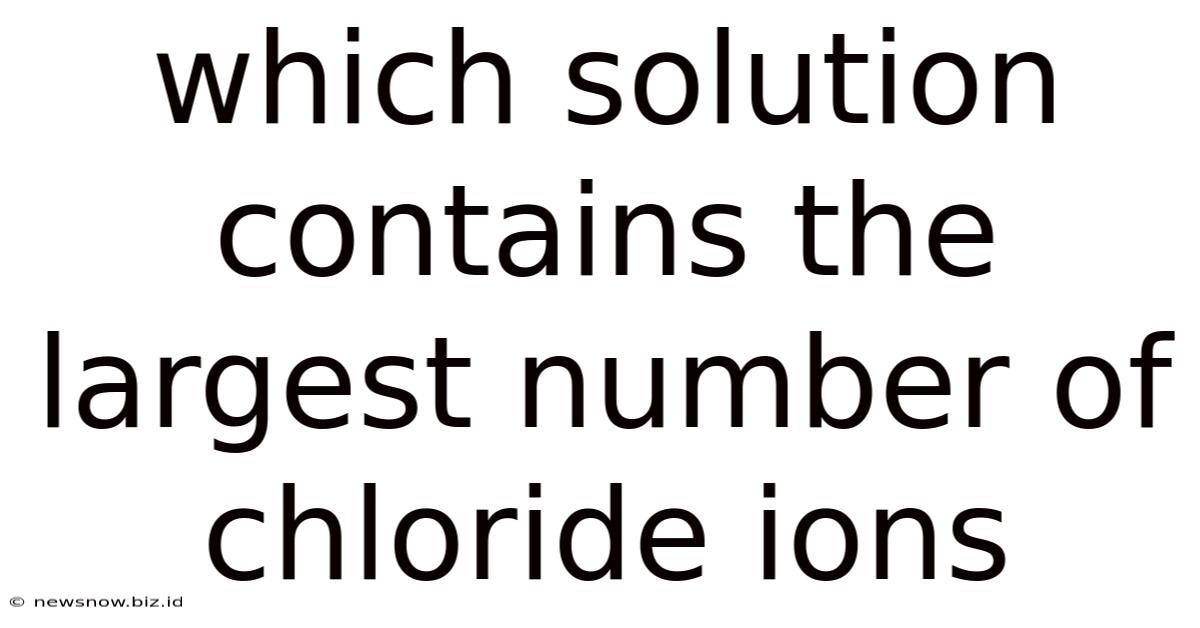Which Solution Contains The Largest Number Of Chloride Ions
New Snow
May 10, 2025 · 4 min read

Table of Contents
Which Solution Contains the Largest Number of Chloride Ions?
Determining which solution contains the largest number of chloride ions requires a careful consideration of several factors: the concentration of the solution, the volume of the solution, and the chemical formula of the solute. This article will delve into the principles behind this calculation, providing practical examples and explanations to help you understand and solve similar problems. We'll explore different scenarios, including solutions with varying concentrations and volumes, and solutions containing different chloride-containing compounds.
Understanding Molarity and Moles
Before we can compare the number of chloride ions, we need to understand the concept of molarity (M). Molarity is a measure of concentration, defined as the number of moles of solute per liter of solution. A mole is a unit of measurement representing Avogadro's number (approximately 6.022 x 10²³) of particles, whether they are atoms, molecules, ions, or other entities.
Calculating Moles
To determine the number of moles of a substance, we use its molar mass. The molar mass is the mass of one mole of a substance, expressed in grams per mole (g/mol). The formula for calculating moles is:
Moles (mol) = Mass (g) / Molar Mass (g/mol)
For example, the molar mass of sodium chloride (NaCl) is approximately 58.44 g/mol (22.99 g/mol for Na + 35.45 g/mol for Cl). If we have 116.88 g of NaCl, the number of moles would be:
Moles (NaCl) = 116.88 g / 58.44 g/mol = 2 mol
Calculating Chloride Ions
Now, let's focus on calculating the number of chloride ions. This is where the chemical formula becomes crucial. In NaCl, there is one chloride ion (Cl⁻) for every one formula unit of NaCl. However, in a compound like magnesium chloride (MgCl₂), there are two chloride ions for every one formula unit of MgCl₂.
Example: Comparing NaCl and MgCl₂ Solutions
Let's compare two solutions:
- Solution A: 1 liter of 1 M NaCl solution
- Solution B: 1 liter of 0.5 M MgCl₂ solution
Solution A:
- Moles of NaCl = 1 L × 1 mol/L = 1 mol
- Moles of Cl⁻ ions = 1 mol NaCl × (1 mol Cl⁻/1 mol NaCl) = 1 mol Cl⁻
- Number of Cl⁻ ions = 1 mol Cl⁻ × 6.022 x 10²³ ions/mol = 6.022 x 10²³ Cl⁻ ions
Solution B:
- Moles of MgCl₂ = 1 L × 0.5 mol/L = 0.5 mol
- Moles of Cl⁻ ions = 0.5 mol MgCl₂ × (2 mol Cl⁻/1 mol MgCl₂) = 1 mol Cl⁻
- Number of Cl⁻ ions = 1 mol Cl⁻ × 6.022 x 10²³ ions/mol = 6.022 x 10²³ Cl⁻ ions
In this specific example, both solutions contain the same number of chloride ions, despite having different concentrations and different solute compounds.
Scenario: Different Volumes and Concentrations
Let's consider a more complex scenario involving different volumes and concentrations:
- Solution C: 2 liters of 0.75 M KCl solution
- Solution D: 1.5 liters of 1 M CaCl₂ solution
Solution C:
- Moles of KCl = 2 L × 0.75 mol/L = 1.5 mol
- Moles of Cl⁻ ions = 1.5 mol KCl × (1 mol Cl⁻/1 mol KCl) = 1.5 mol Cl⁻
- Number of Cl⁻ ions = 1.5 mol Cl⁻ × 6.022 x 10²³ ions/mol = 9.033 x 10²³ Cl⁻ ions
Solution D:
- Moles of CaCl₂ = 1.5 L × 1 mol/L = 1.5 mol
- Moles of Cl⁻ ions = 1.5 mol CaCl₂ × (2 mol Cl⁻/1 mol CaCl₂) = 3 mol Cl⁻
- Number of Cl⁻ ions = 3 mol Cl⁻ × 6.022 x 10²³ ions/mol = 1.8066 x 10²⁴ Cl⁻ ions
In this case, Solution D contains the largest number of chloride ions.
Advanced Considerations: Dissolution and Ionization
It's important to note that these calculations assume complete dissolution and ionization of the solute. In reality, some compounds may not fully dissolve or ionize, which would affect the actual number of chloride ions present. Factors such as temperature and the presence of other ions in solution can influence the extent of dissolution and ionization.
Furthermore, the precision of these calculations is limited by the accuracy of the molar masses used and the precision of the measurements of mass and volume.
Practical Applications
Understanding how to calculate the number of chloride ions in a solution is crucial in various fields, including:
- Chemistry: Stoichiometric calculations, titrations, and equilibrium calculations.
- Environmental Science: Analyzing water quality and determining chloride concentrations in various water bodies.
- Medicine: Formulating intravenous solutions and calculating electrolyte balances.
- Agriculture: Managing soil salinity and irrigation practices.
Conclusion
Determining which solution contains the largest number of chloride ions requires a systematic approach. By carefully considering the molarity, volume, and chemical formula of the solute, and by using the principles of molar mass and Avogadro's number, we can accurately compare the number of chloride ions in different solutions. Remember to account for the number of chloride ions per formula unit of the solute. While the calculations presented here assume ideal conditions, understanding the potential limitations regarding complete dissolution and ionization is crucial for accurate and realistic assessments. This knowledge is valuable in various scientific and practical applications where precise determination of ion concentration is necessary.
Latest Posts
Related Post
Thank you for visiting our website which covers about Which Solution Contains The Largest Number Of Chloride Ions . We hope the information provided has been useful to you. Feel free to contact us if you have any questions or need further assistance. See you next time and don't miss to bookmark.